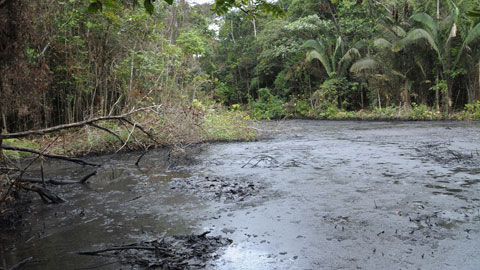Oil contamination in the Amazon modifies chemical composition of rivers

31/07/2017
Oil extraction activities are contaminating the headwaters of the Amazons and modifying the chemical composition of its waters, according to the results of a recent study conducted by researchers from the Institute for Environmental Science and Technology and the Department of Animal Health and Anatomy of the Universitat Autònoma de Barcelona (ICTA-UAB), as well as the International Institute of Social Studies of the Erasmus University Rotterdam (ISS-EUR), which has quantified the environmental impact of oil extraction activities on water contamination in the past three decades.
The research, published in the journal Environmental Pollution, is part of a broader scientific project developed by the ICTA-UAB and the ISS-EUR to analyse the concerning levels of contamination in the Peruvian Amazon area near the border with Ecuador. "Although we were aware of what was happening, there was no scientific evidence of the environmental impact of the area's oil companies. There was no possibilities of quantifying it because these are remote areas with difficult access", explains Antoni Rosell, ICREA researcher at the ICTA-UAB. The study was conducted by analysing data from 2,951 samples of surface water from four Amazon rivers gathered by Peru's public agencies and oil companies between the years 1987 and 2013.
The results demonstrate that the waters contain an extremely elevated presence of chloride, chromium, barium, lead and hexavalent chromium. Some of these compositions are highly contaminating for the environment and a health hazard. Contamination is not only caused by accidental spillages, but also to a large extent by the discharge of produced waters extracted together with the oil and which contain high amounts of heavy metals, hydrocarbons and salt. "Until now we had not assessed the level of contamination produced water causes", says Raúl Yusta, co-author of the study.
For each barrel of oil extracted, oil companies also extracted 98 barrels of produced water, which they dump directly into the ground and rivers of the Northern Peruvian Amazon rainforest from 1972 to 2009. These produced waters contain chloride levels which are 13,379 times higher than normal river levels, while the index of chromium is multiplied by 67, cadmium by 40, lead by 31 and barium by 22.
Researchers estimate that these oil extraction activities have dumped into the riverbeds an average of 5 tonnes of lead, 8 tonnes of hexavalent chromium and 3.7 tonnes of salt per year. These large concentrations of heavy metals and salt are modifying the chemical composition of the headwaters of the Amazon rivers and altering one of the world's most preserved and natural ecosystems. "It is estimated that the water of the Amazon river currently contains 30% more than its natural salt concentration", Rosell points out.
This local contamination resulting from hydrocarbon-related activities has a very broad supra-regional and transnational effects, since spillages in river systems in the headwaters of the Amazon, more specifically in the Corrientes and Tigre rivers, also impacted the lower reaches of the Amazon river. Therefore, pollution spreads throughout thousands of kilometres of rivers, sediment and soil, giving way to a bioaccumulation of heavy metals in fish, animals and people who eat the river fish and hunt the animals that drink produce water, in an attempt to make up for the lack of mineral salts from their habitual diet. "This contamination not only directly affects wildlife in an extremely diverse region in which many species are already in danger of extinction, it also affects local populations which rely on subsistence hunting and fishing as a source of animal protein", says Pedro Mayor, co-author of the study and lecturer at the Department of Animal Health and Anatomy at the UAB.
As a result, the research links this chronic contamination with the high levels of lead and cadmium detected in the blood of 45,000 inhabitants of five indigenous groups living in the region. Although the effects on the health of these inhabitants has not been specifically assessed, researchers do note that these components are neurotoxic and can cause cancer. "For years the indigenous populations have protested against the bad practices of the oil industry, and this even led the Peruvian authorities to declare the area an environmental emergency in 2013 and a health emergency in 2014. Now we have been able to quantify the compounds being dumped", says Martí Orta, co-author of the study, who explains that during many years no one wanted to accept that lead contamination in the rainforest was caused by hydrocarbon-related activities "without taking into account the fact that the million of barrels of produced water dumped into the area indeed contained lead".
Researchers warn that the index of contamination announced by the study could be even higher, given that many of the samples analysed were taken by companies and government agencies without following the established procedures. "Legislation demands that water samples be taken in a radius of 500 metres from the focus of contamination and some of them were taken downriver, up to 36 km from the dumping site", Rosell concludes.
Original article:
Raúl Yusta-García, Martí Orta-Martínez, Pedro Mayor, Carlos González-Crespo, Antoni Rosell-Melé, "Water contamination from oil extraction activities in Northern Peruvian Amazonian rivers" Environmental Pollution, Volume 225, 2017, Pages 370-380, ISSN 0269-7491, http://dx.doi.org/10.1016/j.envpol.2017.02.063.